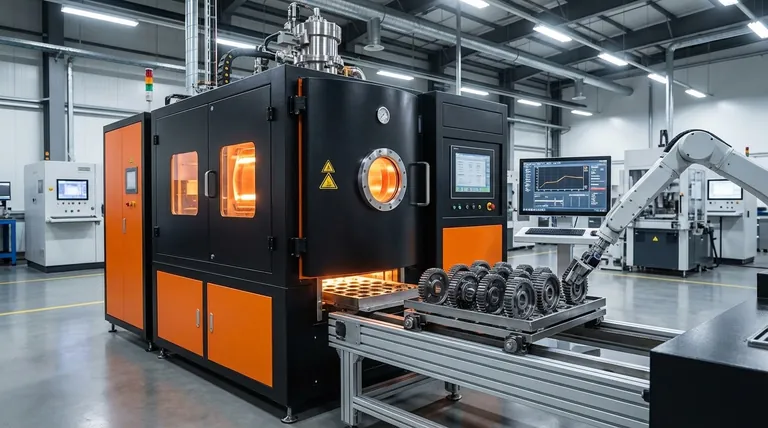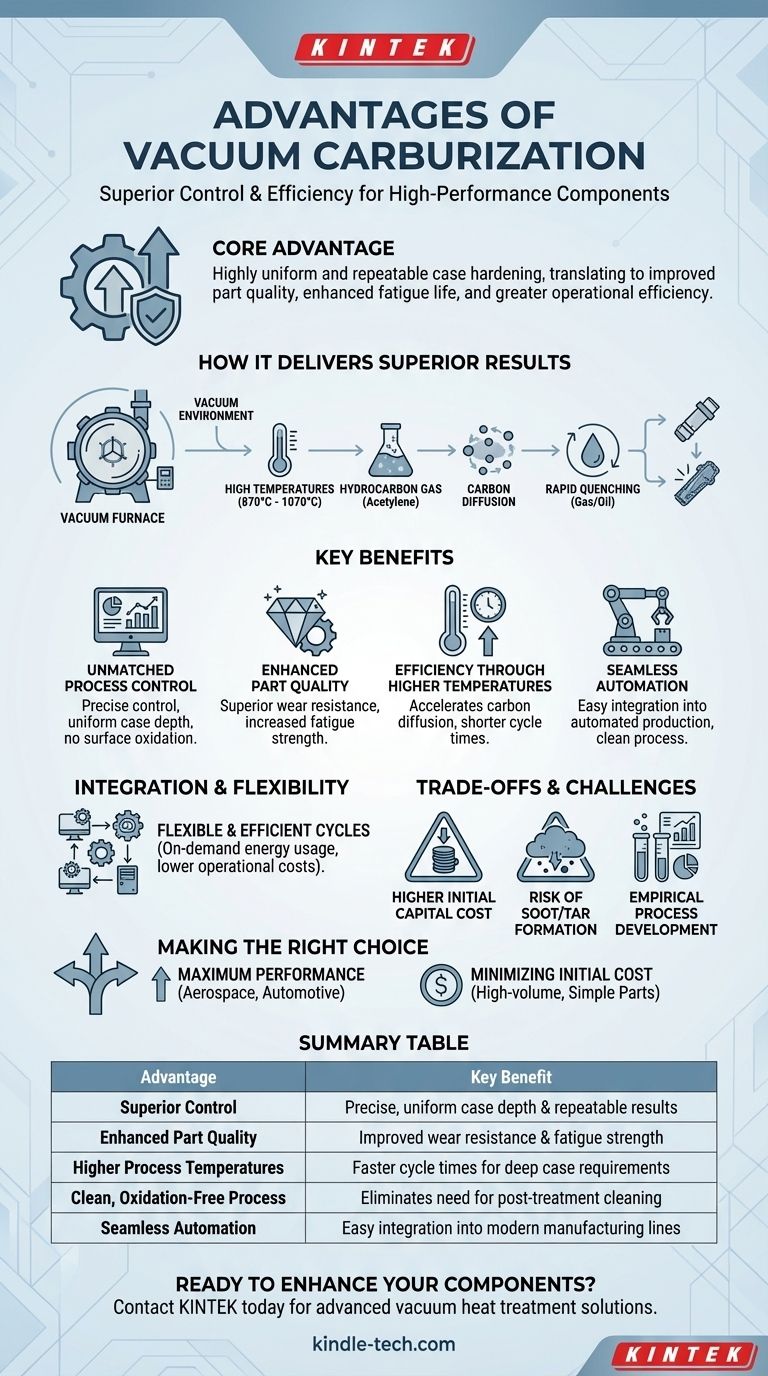At its core, vacuum carburization offers superior control and efficiency over traditional methods. This modern heat treatment process provides significant advantages in producing high-performance, hardened steel components by enabling higher processing temperatures, precise automation, and cleaner integration into manufacturing lines.
The fundamental advantage of vacuum carburizing is its ability to deliver highly uniform and repeatable case hardening. This precision translates directly into improved part quality, enhanced fatigue life, and greater operational efficiency, though it requires a higher initial investment.

How Vacuum Carburizing Delivers Superior Results
To understand the advantages, we must first understand the process. Vacuum carburizing, or Low-Pressure Carburizing (LPC), is a case hardening technique for low-carbon steels.
The Principle of Low-Pressure Operation
The process begins by placing parts in a furnace and creating a vacuum. A hydrocarbon gas, like acetylene, is then introduced at a low pressure.
At high temperatures, typically between 870°C and 1,070°C (1600°F to 1950°F), this gas breaks down, allowing carbon to diffuse uniformly into the surface of the steel parts.
After the desired carbon level is achieved, the parts are rapidly cooled, or quenched, using high-pressure gas or oil to lock in the hardened surface layer.
Unmatched Process Control
The vacuum environment eliminates the possibility of surface oxidation, resulting in cleaner parts and removing the need for post-treatment cleaning.
This precise control over gas introduction and diffusion, often managed by computer simulations, ensures an extremely uniform and repeatable case depth across complex geometries.
Enhanced Part Quality and Performance
By creating a highly controlled, hardened case, vacuum carburizing significantly improves the material's surface properties.
This results in superior wear resistance and a notable increase in fatigue strength, making it ideal for critical components subjected to high stress and cyclical loads.
Efficiency Through Higher Temperatures
The process can operate at higher temperatures than traditional atmospheric carburizing. This accelerates carbon diffusion, which can significantly shorten the overall cycle time for deep case requirements.
Integrating Vacuum Carburizing into Modern Manufacturing
Beyond the metallurgical benefits, the process is uniquely suited for today's advanced manufacturing environments.
Seamless Automation and Integration
Vacuum carburizing furnaces are designed for easy integration into automated production cells. Their clean, self-contained nature allows them to be placed directly in-line with other machining operations.
Flexible and Efficient Cycles
Unlike conventional furnaces that must idle at high temperatures, vacuum furnaces only consume significant energy during the actual treatment cycle. This "on-demand" energy usage reduces overall consumption and operational costs.
Understanding the Trade-offs and Challenges
While powerful, vacuum carburizing is not a universal solution. A clear understanding of its limitations is crucial for making an informed decision.
Higher Initial Capital Cost
The primary disadvantage is the high initial investment in equipment. The complexity of the vacuum furnace and its control systems makes it significantly more expensive than traditional atmospheric furnaces.
The Risk of Soot and Tar Formation
Improper control of the hydrocarbon gas type, pressure, or flow rate can lead to the formation of soot and tar on the parts and inside the furnace, requiring specialized cleaning and maintenance.
Empirical Process Development
While highly controllable, dialing in the optimal cycle for a new part often requires an empirical approach. This involves running test loads to fine-tune the gas and diffusion steps, demanding a higher level of technical expertise.
Making the Right Choice for Your Goal
Ultimately, the decision to use vacuum carburizing depends on your specific technical and business requirements.
- If your primary focus is maximum performance and repeatability: For critical, complex components like aerospace gears or high-performance automotive parts, the superior control and quality of vacuum carburizing are essential.
- If your primary focus is minimizing initial capital investment for simple parts: For less critical, high-volume components, the lower cost and established nature of conventional gas carburizing may be the more practical choice.
Choosing vacuum carburization is an investment in precision, quality, and the long-term reliability of your most critical components.
Summary Table:
| Advantage | Key Benefit |
|---|---|
| Superior Control | Precise, uniform case depth and repeatable results |
| Enhanced Part Quality | Improved wear resistance and fatigue strength |
| Higher Process Temperatures | Faster cycle times for deep case requirements |
| Clean, Oxidation-Free Process | Eliminates need for post-treatment cleaning |
| Seamless Automation | Easy integration into modern manufacturing lines |
Ready to enhance the performance and reliability of your critical components?
KINTEK specializes in advanced lab and production equipment, including vacuum heat treatment solutions. Our expertise helps you achieve superior case hardening with unmatched precision and efficiency.
Contact us today to discuss how vacuum carburizing can solve your high-performance manufacturing challenges!
Visual Guide

Related Products
- Vacuum Heat Treat Furnace and Levitation Induction Melting Furnace
- Vacuum Heat Treat Furnace with Ceramic Fiber Liner
- Vertical Laboratory Quartz Tube Furnace Tubular Furnace
- Molybdenum Vacuum Heat Treat Furnace
- Vacuum Heat Treat and Molybdenum Wire Sintering Furnace for Vacuum Sintering
People Also Ask
- Why do you heat treat in a vacuum? Achieve Perfect Surface Finish and Material Integrity
- What is a vacuum heat treatment furnace? The Ultimate Guide to Controlled Atmosphere Processing
- How does heat treatment process work? Tailor Material Properties for Your Application
- What is low temperature vacuum? A Guide to Precision, Oxide-Free Thermal Processing
- What are the three main heat treatments? Mastering Annealing, Hardening & Tempering



















